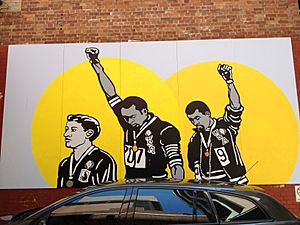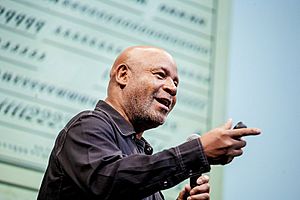Emory Douglas facts for kids
Quick facts for kids
Emory Douglas
|
|
|---|---|

Douglas in 2017
|
|
| Born | May 24, 1943 |
| Known for | Graphic design, painting, collage, drawing |
| Movement | Black Power/Black Arts Movement |
Emory Douglas (born May 24, 1943) is an American graphic artist. He was a key member of the Black Panther Party from 1967 until the group ended in the 1980s. As their Revolutionary Artist and Minister of Culture, Douglas created powerful images. These images showed the challenges faced by Black Americans.
Contents
Early Life and Education
Douglas was born in Grand Rapids, Michigan. When he was eight, his family moved to San Francisco, California. At age 13, he spent time at a youth training school. There, he worked in the printing shop. This is where he learned the basics of commercial printing.
In 1960, Douglas studied graphic design at the City College of San Francisco. He joined the college's Black Students’ Association. He also worked with Amiri Baraka, a leader in the Black Arts Movement. Together, they designed sets for plays.
Art and Activism
Joining the Black Panther Party
Douglas joined the Black Panther Party (BPP) in 1967. He met the group's founders, Huey P. Newton and Bobby Seale. He was drawn to the BPP because they focused on self-defense. He felt that non-violent protests at the time did not appeal to him. He could relate to the rebellions happening in cities like Watts and Detroit.
Douglas told the BPP founders he could help improve their newspaper. This newspaper was called The Black Panther.
Art for the Black Panthers
In 1967, Douglas became the Revolutionary Artist and Minister of Culture for the BPP. He redesigned The Black Panther newspaper. He made it possible to print in color and add more graphics.
Douglas created many famous images for the BPP. He drew pictures that protested against police brutality. He also illustrated the Party's 10-Point program. This program included ideas for social services and good housing. His art also connected the BPP with other global movements fighting for freedom.
In 1970, Douglas helped start a musical band called The Lumpen. He chose the name "The Lumpen." This name was inspired by ideas about ordinary people and their struggles.
Later in 1970, the BPP changed its focus. They began to emphasize "survival programs" instead of violence. Douglas's art changed too. He started showing Black Americans getting free food and clothes. These programs offered free breakfast, health clinics, and legal help. The FBI increased its efforts against the BPP. The Party eventually ended in 1982. However, their ideas continue to inspire people today.
A reporter named Jessica Werner Zack wrote about Douglas in 2007. She said he created the strong image of the Panthers. He used the newspaper's popularity to encourage people to act. The newspaper reached nearly 400,000 copies at its peak in 1970. His art showed poor people with real understanding. They were not victims, but ready to fight for their rights.
Douglas also designed postcards, flyers, and posters. These were used to recruit new members. They also spread the BPP's ideas. Douglas said he wanted to draw in a way that even a child could understand. This helped him reach the most people.
Later Activism and Art
Douglas found inspiration from freedom struggles around the world. He used art as a main way to spread ideas and reach people. His graphics promoted the Party's beliefs. These beliefs were inspired by leaders like Malcolm X and Che Guevara. His images were often very strong. They aimed to encourage Black resistance. The goal was to start a revolution to end unfair treatment of African Americans.
After The Black Panther newspaper stopped, Douglas worked for over 30 years. He worked at the San Francisco Sun Reporter, a newspaper for the Black community. He kept creating art that supported activism. His artwork remained important. Greg Morozumi, an art director, said Douglas's art inspires rebellion. It also helps create new revolutionary culture.
After his time with the Black Panther Party, Emory Douglas continued to use his art for important social issues. He focused on problems like violence within the Black community. Douglas highlighted that bigger issues like poverty and unfair systems cause such violence. His art often showed themes of strength and community. He urged people to work together to solve these problems.
Douglas's later work focused on finding solutions to reduce violence. He also aimed to build stronger communities. He used art to make people think and act. He stressed the need to fix the root causes of violence. Douglas worked with art groups, teachers, and activists. He showed that art and community action are both needed for social change.
His work shows his belief that art should be a tool for justice and equality. He continues to show his art and talk with people worldwide. This shows his dedication to helping people in marginalized communities.
In 2006, artist Sam Durant put together a book about Douglas's work. It was called Black Panther: The Revolutionary Art of Emory Douglas. Many people contributed to this book.
After the book came out, Douglas had art shows. These shows were at the Museum of Contemporary Art, Los Angeles (2007–08) and the New Museum in New York. Since then, his early work has been shown to new audiences. He continues to create new art. He exhibits and talks with people all over the world. His international shows include places like Urbis, Manchester (2008), and Lisbon (2011).
Colette Gaiter, a professor, wrote about Douglas. She said he was the most active graphic artist in the American Black Power movements. Douglas understood how powerful images are for sharing ideas. Cheap printing allowed him to make a weekly newspaper with many illustrations. He used art techniques to create strong images with little money or time. His drawings had thick black outlines and interesting textures. Douglas's images had two goals. First, they showed why a revolution was needed. Second, they created a visual story of power for people who felt helpless. He showed poor people with respect and care. He kept their dignity while showing tough situations.
Douglas is now retired. But he still does freelance design work. He discusses topics like violence within the Black community and the prison system. His newer works often feature children. He believes he must keep educating people through his art.
Collaborations
Douglas has worked with other artists on projects:
- EDELO (En Donde Era La Onu): This was a collection of embroideries in Chiapas, Mexico. It was a collaboration with Douglas, the Woman’s Zapatista Embroidery Collective, and Caleb Duarte.
- 2011-14, Peace heals, war kills: This was with Australian Indigenous artist Richard Bell.
- 2014, We Can Be Heroes: This was also with Richard Bell. Both artists combined their experiences from the Indigenous rights movements in Australia and the Black Power movement in America. Their work showed Australian Peter Norman standing with African Americans Tommie Smith and John Carlos at the 1968 Summer Olympics medal ceremony.

- 2018, Black Lives Matter Global Network with Frieze NY: This was for an art fair. It showed Douglas's work called We Shall Survive Without A Doubt. This work was on the back cover of The Black Panther, Issue #30.
- 2020, Da 5 Bloods: Douglas worked with filmmaker Spike Lee. He adapted his graphic against the Viet-Nam war from The Black Panther newspaper for Lee's film Da 5 Bloods.
Exhibitions
Douglas's art has been shown in many exhibitions:
- 2007-08, Museum of Contemporary Art, Los Angeles; Black Panther: The Revolutionary Art of Emory Douglas.
- 2008, Station Museum of Contemporary Art, DEFENDING DEMOCRACY.
- 2008-09, Urbis, Black Panther: Emory Douglas and the art of revolution.
- 2009: The New Museum, Emory Douglas: Black Panther.
- 2016-17, Urban Justice Center, We Have Nothing to Lose but Our Chains.
- 2016-17, Oakland Museum of California, All Power to the People: Black Panthers at 50.
- 2017, Tate Modern, Soul of a Nation: Art in the Age of Black Power.
- 2018, Los Angeles Contemporary Exhibitions, Emory Douglas: Bold Visual Language.
- 2018, Denison Museum at Denison University, Emory Douglas: Revolutionary Artist of the Black Panthers.
- 2021, Storage Art Gallery, Tribeca curated by Onyedika Chuke, Storage_.
Awards
- 2015, AIGA Medal.
- 2019, San Francisco Art Institute's Honorary Doctor of Fine Arts.


